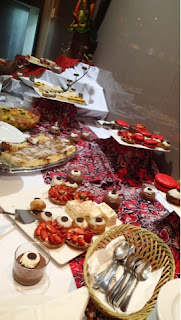Many of the conference attendees went on a day trip to Amedee Island. This included a glass bottom boat ride, a barrier reef cruise, drinks, a buffet lunch, and cultural demonstrations including dancing, climbing a coconut tree, and tying a sarong. Snorkeling was an option for an extra fee, but for me I wanted to spend as much time in the water as I could. I tried to find someone to take me out snorkeling for the day, but I was having a hard time finding anyone who was available. Mary-Clare stepped in and save the day. She found Oli who runs the Coconut Watertaxi. I recruited three others to join me - Steve, Kris, and Jeanine. You can check out Oli's services at:
http://www.coconuttaxiboat.com/index.php?page=accueil&langue=en
Mary-Clare loaned us her ice chest and gave us two bags of ice. Her husband picked us up at our hotel and took us to the boat ramp were we met Oli at 8 am on Friday. Mary-Clare, her staff, and the Fijian librarians were such wonderful hosts throughout the conference, and this was definitely above and beyond the call of duty.
The four of us spent around 3 hours snorkeling in two different areas. The first had high reaching coral heads with sand channels about 20 to 25 feet deep around them. The variety of hard coral species was impressive as was the size of many of the coral heads. The second spot was much more shallow with the corals so close to the surface you couldn't swim over the reef. Instead we swam around the edge of the reef. Here the sand channels were closer to 10 feet deep. The water was also warmer because of the shallow depth and the sun reflecting off the white sand in the channels. I was glad I brought my "Palmyra" wetsuit as I was cold by the time we finished our first dive in the colder, deeper water.
 |
| Jeanine & Kris enjoying our ride out to the barrier reef |
 |
| view of the coral reef from the boat |
Here are some coral photos to give you an idea of the number of species and how large some of the coral heads are. I felt New Caledonia and Fiji were much more impressive in terms of corals than what I saw diving on the Great Barrier Reef. Of course the GBR is huge, and I might not have been diving in the best spot. Did you know that the barrier reef of New Caledonia is the world's second largest after Australia's GBR?

Here are some fish photos. I felt the GBR had schools of larger fish that I did not see here. In terms of number of fish, Fiji had more than both New Caledonia and Australia. There were clouds of small fish off the island where Steve and I dove when we visited Fiji in 2008.
 |
honeycomb grouper
Epinephelus merra |
 |
blue damsel fishes + one Humbug
Pomacentrus pavo
Dascyllus anuanus |
 |
reef lizardfish
Synodus variegatus |
 |
yellow long nose butterflyfish on left
Forcipiger flavissimus |
 |
southseas devil or Fiji damsel
Chrysiptera taupou |
 |
steephead parrotfish
Chlorurus microrhinos |
 |
a pair of oval butterflyfish
Chaetodon lunulatus |
On to the invertebrates. First we have some echinoderms.
 |
red slate pencil urchin
Heterocentrotus mammillatus |
 |
rock-boring sea urchin
Echinometra mathaei |
 |
leopard sea cucumber
Bohadschia argus |
Here are some mollusks.
 |
tiger cowrie
Cypraea tigris |
 |
| Can you pick out the two giant clams in this photo? |
 |
close up of one of the two giant clams
Tridacna sp. |
Here is a picture of Kris checking out the ship wreck on the outside of the barrier reef as we motor between snorkel sites.
 |
| Kris Anderson looking at the Ever ProsperityII wreck on the distant reef |
After our snorkel, Oli dropped us off on Maitre Islet where we had our picnic lunch. That will be the topic of my next blog entry.























































